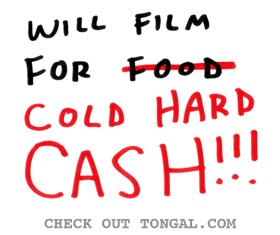Beardy’s Note: Today I’m happy to bring you folks a very special guest post that was written by a longtime friend of VCN; MOFILM’s director of social media, Kerry Gaffney. Kerry’s going to let you you know how you can apply with Mofilm to get cash to pay for your Mofilm video contest entries. It sort of sounds to good to be true but it’s legit; Mofilm is now paying out production grants to filmmakers left and right. Need some money to hire actors or rent a nicer camera or build some outrageous prop or buy a new piece of editing software? Mofilm wants to help make any and all of that happen. Here’s how you can get a slice of their sweet, production grant pie:
______________________________
There are lots of reasons why people like to enter video contests. And there are also lots of reasons why they don’t enter; usually it’s because they run out of time or because they don’t have the money to do their idea justice. MOFILM can’t help with the time element but we’re now doing our best to help with the money side with the introduction of Production Grants.
When we were running the Chevrolet Super Bowl contest last year, we really encouraged filmmakers to make their entries as big and bold as possible. The winning spot had the chance of being aired during the telecast of the Super Bowl LXVI. So we wanted to make sure that all the entries were great enough to stand shoulder to shoulder with, or be even better than, the big agency ads. That’s why we launched the MOFILM Production Grant program. Open to any filmmaker from anywhere around the world, all they had to do was apply; sharing their concepts and giving as much supporting material as they felt like. We gave out over $100,000 last fall and the scheme was so successful we decided to include production grants for as many of our contests as we possible could.
So far in 2012 we’ve approved over $140,000 in grants for 14 different contests to over 100 filmmakers. That’s not a typo, just in January we’ve approved almost $150,000. That’s in addition to the $300,000 in prizes across our Sydney, Barcelona and Texas contests.
So how does it work? It’s easy; go check out the open contests on MOFILM and pick a brand. If there are production grants available there will be a link to the application form right from that page. You need to be quick though, the grants go fast so the sooner you get your application in the better.
For the application we want to know who you are, what your concept is, how much money you’d like (there’s usually a guide as to what’s available on the form) and what you plan to spend the money on. A member of the MOFILM team will then review the applications and decides who gets what. Anyone can apply but your odds of being successful are increased if you have a great idea (natch), have some supporting material like a script or a storyboard, and examples of previous work either with MOFILM or in a link to your showreel on your MOFILM profile.
Once you’ve been told you’ve been successful, you’ll be sent an approval form to fill in and sign. Then you can get on and create. You can bounce ideas off the account manager or ask for advice and feedback. Although, any filmmaker entering one of our contests can do that by asking on or with an email to . Once you’re ready, and before the deadline, upload your video and all the relevant release forms. One of the MOFILM team will then be in touch to ask for receipts and bank details. Once we have that we’re good to make payment and we’ll reimburse your approved expenses. After that, all you have to do is wait to find out if you won!!
—- Guest Post by Kerry Gaffney. Follow Kerry on Twitter —-




















